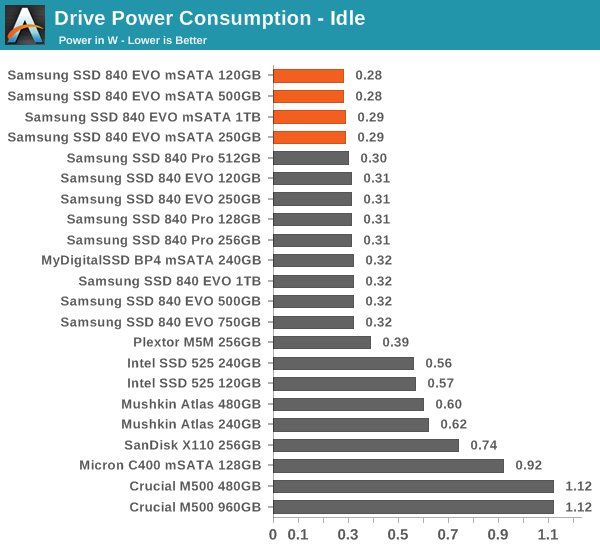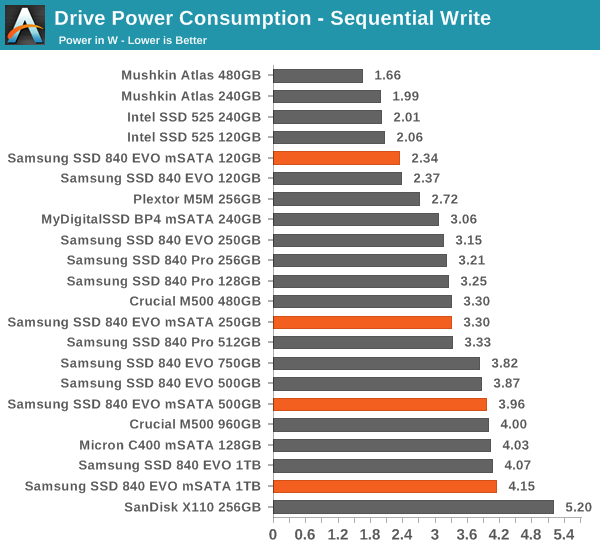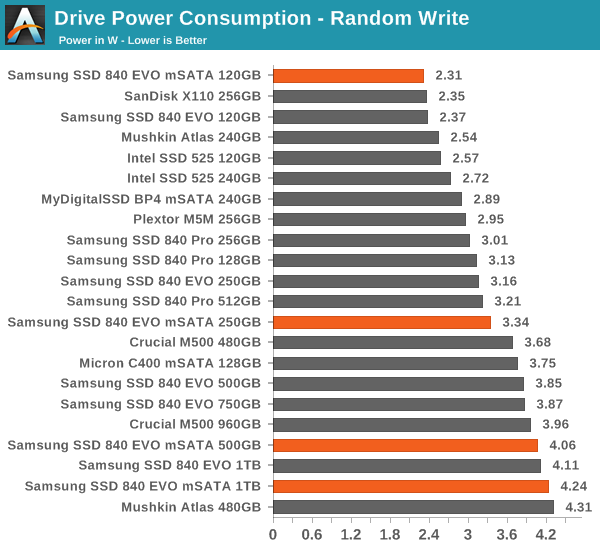Samsung SSD 840 EVO mSATA (120GB, 250GB, 500GB & 1TB) Review
by Kristian Vättö on January 9, 2014 1:35 PM ESTPower Consumption
One problem we have with testing mSATA SSDs is the fact that they require an mSATA to 2.5" adapter with a voltage regulator since 2.5" SATA is 5V whereas mSATA spec is rated at 3.3V. If you were to connect an mSATA SSD to a native mSATA slot, the power supply would automatically provide the drive with a voltage of 3.3V (SATA spec has three voltage rails: 3.3V, 5V and 12V) but because we have to deal with an adapter, the current we're measuring is based on the 5V rail (which the voltage regulator then changes to 3.3V). The voltage itself isn't the issue because it's fairly safe to assume that the adapter provides 3.3V to the drive but figuring out the difference between the input and output currents of the voltage regulator is. With the help of one of our readers (thanks Evan!), we were able to find out that the delta between input and output currents is typically 8mA (i.e. 0.008A) in the voltage regulator used in our adapter. Our measurements confirmed that as the adapter drew 8mA without a drive connected to it, although under load the regulator may draw a little more than that (datasheet claims a maximum of 20mA).
As we now know the difference between the input and output currents (current on 5V rail minus 8mA) as well as the voltage of the drive (3.3V), we're able to measure the actual power consumed by the drive. I've updated all mSATA SSD results to correspond with the change, so the number's you're seeing here are different from the ones you've seen in earlier reviews.
The EVO mSATA has great power characteristics, just like it's 2.5" sibling. There's no significant difference between the two and overall the EVO mSATA is one of the most power efficient mSATA drives. Unfortunately I don't have the necessary equipment to test slumber power consumption (HIPM+DIPM enabled) but I'd expect the EVO mSATA to have numbers similar to the 2.5" EVO (see the chart here).
The numbers here are worst-case scenarios and something I noticed during testing was that it takes a while for EVO to reach its maximum power draw. With the 500GB and 1TB models, the power draw was ranging between 2.2W and 2.5W for up to 30 seconds or so until it jumped to over 4W. I'm guessing this is due to TurboWrite because there is less NAND in use when the SLC buffer is employed (you simply don't need as many die to achieve high performance since program/erase times are much shorter). Once the buffer is full, the drive has to start writing to the TLC portion of the NAND, which increases the power draw as more NAND is in use. The downside is once you stop writing, the drive will keep drawing high power for a while in order to move the data from the SLC buffer to the TLC NAND. For example the 1TB model kept drawing ~3.5W for about a minute after I had stopped writing to the drive. I like Samsung's method because the garbage collection is done immediately instead of waiting for long idle periods like some manufacturers do -- doing garbage collection actively recovers performance quicker whereas it may take hours for idle garbage collection to kick in.













65 Comments
View All Comments
spejr - Tuesday, January 14, 2014 - link
Why do people still use mSATA? It might not make a difference for IOPS, but when opening a program the higher sequential read of PCIe would be a benefit. The NAND could supposedly go faster than 540.Kristian Vättö - Wednesday, January 15, 2014 - link
Because the support for PCIe is very limited. There are only a handful of laptops that use PCIe SSDs (and some of the have a proprietary connector like the MacBook Air) and in the desktop world all PCIe SSDs are currently just two or more SATA SSDs in RAID (though that will change during the next few months).bbordwell - Wednesday, January 15, 2014 - link
Any chance we could get an in depth review of Samsung's RAPID now that it is available on both the EVO and the PRO? I am curious if it would have a larger impact for writes on the PRO than the EVO since the PRO does not have the SLC write cache.RShack - Friday, January 17, 2014 - link
What % of your responses are to posters who evidently haven't bothered to even read the dang article?swiftdimension - Friday, January 17, 2014 - link
Just curious, if you guys connect a mSATA drive by letting it dangle connected to power and a SATA cable since the Asrock z68 Pro 3 doesnt have a mSata slot?Kristian Vättö - Saturday, January 18, 2014 - link
We use an mSATA to SATA 6Gbps adapter.Qlaras - Friday, January 17, 2014 - link
So I was considering ordering one of Gigabyte's sole AMD Brix - GB-BXA8-5545, and a 180-240GB mSATA SSD. (Now that the Brix is FINALLY released)Torn between waiting for the Samsung 840 EVO mSATA and just paying the premium for an Intel 525 and getting it now.
The Samsung has newer features/tech, and the price will (probably) be lower - MSRP matches what the 525 is going for now though, and the 525 comes with a 5-year warranty, versus 3 on the EVOs.
Thoughts?
Kristian Vättö - Saturday, January 18, 2014 - link
Crucial M500 should be a good compromise -- it's available now and the pricing is competitive.Coup27 - Saturday, January 18, 2014 - link
Did that maximum bus speed vs latency graph really come from Micron? It's clearly been drawn in MS Paint. The Y axis isn't even vertical!Good article nevertheless.
Kristian Vättö - Sunday, January 19, 2014 - link
Yup, here's the presentation (slide 9): http://www.flashmemorysummit.com/English/Collatera...